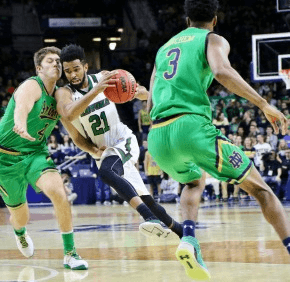By Jeff Seidel
Special to the Review
Van Brooks sits in the middle of his recently-opened SAFE Center in West Baltimore and watches everything, usually with a smile on his face. He offers advice to children about homework, talks to them about upcoming programs and quietly directs the adults helping out.
Working with kids wasn’t part of his original plan in life, but Brooks is here now and clearly a satisfied man.
“God, that’s the only reason I’m here,” Brooks said. “From my injury and why I’m sitting in this building. It was his plan, and I accept it.”
Brooks loved football growing up, and developed into a solid defensive back for Loyola Blakefield. He played in the 2003 Turkey Bowl, helping the Dons beat Calvert Hall, but his life changed the next season.
Making a tackle at Georgetown Prep in 2004, Brooks broke his neck, a catastrophic injury that left him paralyzed; he uses a wheelchair for mobility.
His life changed, but Brooks, now 27, kept right on going, graduating from Loyola and then Towson University, and following up on an idea that popped into his head one night.
Determined not to be limited, Brooks told his parents that he wanted to own his own business by the age of 25. He made it happen, opening that SAFE Center, a youth facility in the Franklin Square area of West Baltimore Oct. 19.
 Brooks drew up plans for the facility, and purchased a building on West Lexington Street. His father (also Van Brooks) handled the renovation in his spare time over the past 12-18 months.
Brooks drew up plans for the facility, and purchased a building on West Lexington Street. His father (also Van Brooks) handled the renovation in his spare time over the past 12-18 months.Part of the Safe Alternative Foundation for Education, which Brooks founded in 2012, the center can meet the needs of up to 30 kids in a 1,500-square-foot building that has three different areas – a kitchen/office, a room with three large TV screens plus space used for homework and other programs. And it is all happening in the neighborhood in which he grew up.
“My days of why and asking that question are over – long gone,” Brooks said of his 2004 injury. “Now, it’s ‘why not me?’ ”
The center, open Monday through Friday, already is buzzing with activity most afternoons. Kids come in after school; they are required to do homework first, before being able to relax and move to other activities.
Shelly Brooks, Van’s mother, has been busy helping at the center and loves being able to do it. She and her husband pushed their son to keep moving forward after his injury.
“When he got hurt, we didn’t want him to think that was the end of life for him,” she said. “We were there for him. Whatever it took, we were going to be there for our son.”
Brooks continues to improve physically. His initial paralysis was from the neck down; now it’s from the waist down. In therapy, he walks using a walker.
He regularly returns to Loyola for various activities and plans on attending this year’s Turkey Bowl. Loyola recognized his achievements last year, when it gave him its initial “For Others Award.”

Van Brooks continues to wear his Loyola Blakefield class ring. (Olivia Obineme/Special to the Review)
“It meant a lot to me because the mission of Loyola is to become men for others,” Brooks said. “So to be awarded that … was great because that’s what I was taught.”
Brant Hall, now the Dons’ head coach, worked with Brooks for two years as an assistant, and isn’t surprised at how he has moved on.
“Van’s injury did not damage his mental state, and I believe it made him stronger,” Hall said. “I know that Van will continue to give back to his community and help change the lives of all those that he comes in contact with.”
Loyola Blakefield meets Calvert Hall in the 96th Turkey Bowl Thanksgiving Day, Nov. 26 at 10 a.m., at M&T Bank Stadium.
Also see:
Gov. Hogan and Comptroller Franchot volunteer at Our Daily Bread


